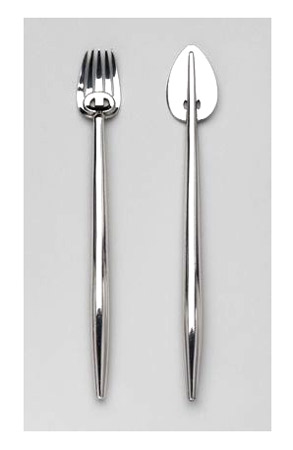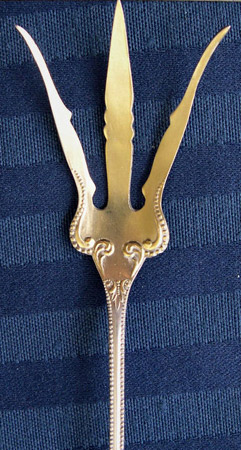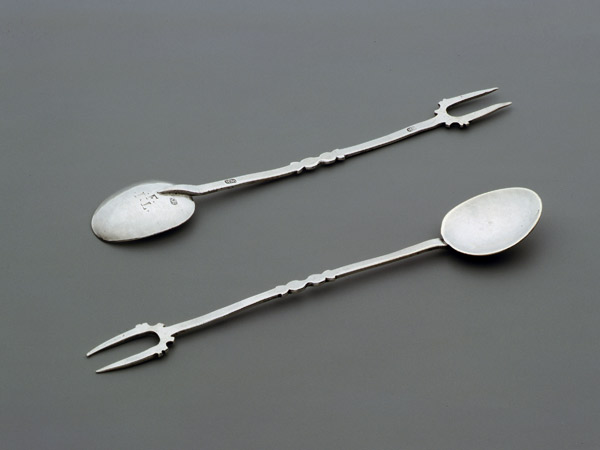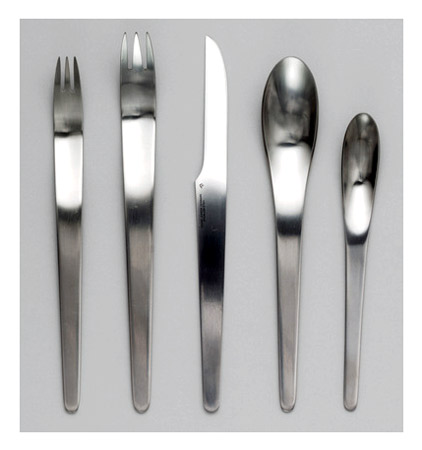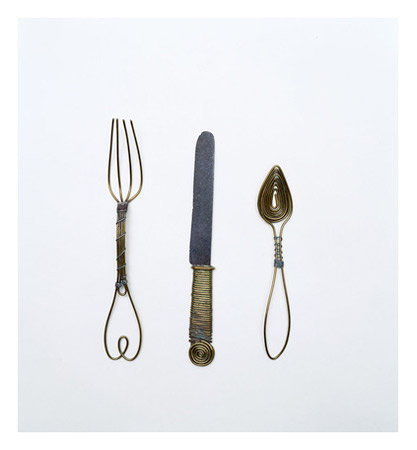The Rise of the Fork
Knives and spoons are ancient. But we’ve only been eating with forks for a few centuries.

Courtesy of V&A Museum.
If you live in Europe or the Americas, you likely pick up a fork every day and give no thought to it, unless you’re selecting flatware for a wedding registry or you happen to have recently returned from Asia. Using it probably seems as natural as breathing. And yet it is a bizarre object, as Charles Simic suggests in his poem “The Fork”:
This strange thing must have crept
Right out of hell.
It resembles a bird’s foot
Worn around the cannibal’s neck.
As you hold it in your hand,
As you stab with it into a piece of meat,
It is possible to imagine the rest of the bird:
Its head which like your fist
Is large, bald, beakless, and blind.
The success of Simic’s poem—one of a series of “object-poems” he attempted in the ’60s when frustrated with his work—lies in its ability to evoke strangeness and horror in an everyday experience. But that kind of emotion is not latent in everything we touch (which may explain why Simic gave up on his object-poems pretty fast). Perhaps the fork is potent and intriguing because it is surprisingly modern. Humans got along just fine without forks for thousands of years. Which means we are, in a sense, still learning to use this small instrument. And our changing fork habits can reveal our attitudes about big subjects, including religion, masculinity, and foreignness.

Photo by Marie-Lan Nguyen via Wikimedia Commons.
The fork is a latecomer to the table. Knives are the descendants of sharpened hand axes—the oldest human tools. It is likely that the first spoons derived from whichever local objects were used to scoop up liquid: The word for spoon in both Latin and Greek derives from a snail shell while the Anglo-Saxon spon means chip. The shape of the fork has been around a lot longer than the eating utensil. In ancient Greece, Poseidon brandished a trident while mortals had large forked tools to pull food out of boiling pots. But the fork didn’t have a place at the Greek table, where people used spoons, knife points, and their hands.
Sporadically, the fork made inroads. In the eighth or ninth century, some Persian nobility may have used a forklike tool. In the 11th century, forks were in use in the Byzantine Empire. An illustrated manuscript from that period shows two men using two-pronged forklike instruments at a table, and St. Peter Damian, a hermit and ascetic, criticized a Byzantine-born Venetian princess for her excessive delicacy: "[S]uch was the luxury of her habits … [that] she deigned not to touch her food with her fingers, but would command her eunuchs to cut it up into small pieces, which she would impale on a certain golden instrument with two prongs and thus carry to her mouth." Damian was sufficiently offended by the woman’s table manners that when she died of the plague, he regarded it as a just punishment from God for her vanity.
While Damian’s condemnation was unusually strict (this was also a man who described the first grammarian as the devil), the fork was commonly viewed with skepticism or even outright hostility. In a historical overview of cutlery in Feeding Desire, the catalog for a 2005 exhibition on the tools of the table, Sarah Coffin speculates that the fork's image problem could be connected to its resemblance to the devil's pitchfork (a word from which it derives its name).
In the Middle Ages, most people ate off rounds of stale bread called trenchers, which could hold cooked meat and vegetables and which could be brought directly to the mouth; knives and spoons could handle anything else that a hand couldn't. Forks, having journeyed to Italy from Byzantium, arrived in France along with Catherine de Medici, who traveled in 1533 from Italy to France to marry Henry II. The political culture of 16th-century France was riven by sectarian violence, and Catherine, in her role as mother to two child-kings, used massive public festivals to demonstrate the power of the monarchy. Food was part of this strategy of spectacle. Catherine's eating methods, as well as foods as diverse as the artichoke and ice cream, went on display as she toured the country for more than a year in the 1560s, drumming up support from the populace and devising etiquette that forced members of rival factions to eat together at her table.

V&A Museum.
At this time, most forks were two-pronged, and either hefty enough to hold down a cut of meat (similar to what we would think of today as a carving fork) or so dainty they were used primarily to eat sweets at the end of meals. Forks were used occasionally, but not every day. Montaigne, writing in the 1570s in a passage about the force of habit, mentions forks but says he rarely uses them. And they were still associated with sinister behavior. In an essay in Feeding Desire on the sexual politics of cutlery, Carolin Young notes that in 1605, an anonymous allegorical novel about the courtiers of Henry III portrayed a mysterious island peopled by hermaphrodites, whose behavior is characterized by theatricality, artifice, and falsehood. Sure enough, the hermaphrodites eat with forks, spilling more food than they manage to consume in their pursuit of the new and the unnecessary. Young traces the “unsettlingly effeminate aura” of the fork all the way through 1897, when British sailors are still eating without forks, considering them to be unmanly.

V&A Museum.
In the time of Henry III, fork-owners would have been well-off, and most of them would have had one set of cutlery that traveled with them; there are numerous examples of forks and knives housed in carrying cases that could be slung over a shoulder or around a waist. It wasn't until the late 1600s and early 1700s that people began to purchase multiple sets of silverware for their homes, which were just beginning to be equipped with rooms specifically set aside for dining. It was also around this time that forks with three and then four tines were made. Even as the fork gained ground, it was not universally accepted. As Ferdinand Braudel notes in The Structure of Everyday Life, around the beginning of the 18th century, Louis XIV forbade his children to eat with the forks that their tutor had encouraged them to use. But by the middle of the century, the use of the fork had become sufficiently normal that rebukes were reserved for those who used forks incorrectly. In 1760, François Baron de Tott, a French aristocrat and military officer, gave this account of an overly mannered dinner party in Turkey: "A circular table, with chairs all around it, spoons, forks—nothing was missing except the habit of using them. But they did not wish to omit any of our manners which were just becoming as fashionable among the Greeks as English manners are among ourselves, and I saw one woman throughout the dinner taking olives with her fingers and then impaling them on her fork in order to eat in them in the French manner."

Morristown National Historical Park, National Park Service Museum Collection.
By the beginning of the 19th century, the fork was firmly established on the French table and beyond, and the table had become a center of social life not just for the aristocracy, but for the newly established bourgeoisie. In 1825, a judge named Jean Anthelme Brillat-Savarin published The Physiology of Taste: Or Mediations on Transcendental Gastronomy, and in it he paints a portrait of a world increasingly preoccupied with the culture of dining. In addition to penning aphorisms including “a dinner without cheese is like a beautiful woman with only one eye,” he distinguished between eating to satisfy a need and eating as a social activity: “The pleasure of eating is one we share with animals; it depends solely on hunger and what is needed to satisfy it. The pleasures of the table are known only to the human race; they depend on careful preparations for the serving of the meal, on the choice of place, and on the thoughtful assembling of guests.”
Brillat-Savarin loved the rules of the table—the proper room temperature for a dinner party is 60 to 68 degrees Fahrenheit, in case you're taking notes—but even he found contemporary manners a but fussy. He writes, in discussing life around 1740, that it was "during this period that there was generally established more orderliness in the meals, more cleanliness and elegance, and those various refinements of service which, having increased steadily until our own time, threaten now to overstep all limits and lead us to the point of ridicule."
For the contemporary eater, Brillat-Savarin's words might come to mind when looking at some flatware patterns from the late 18th or early 19th centuries. Most utensils before the 18th century were made of silver—the metal that reacts the least with food—but silver is rare. The invention of silver-plating techniques, accompanied by the vigorous expansion of the consumer market, resulted in scores of forks for eaters of all classes and in scores of different fork types: oyster forks, lobster forks, salad forks, terrapin forks, berry forks, lettuce forks, sardine forks, pickle forks, fish forks, and pastry forks—just to name a few. By 1926, the multiplication of silverware had gotten so overwhelming that then-Secretary of Commerce Herbert Hoover and the Sterling Silverware Manufacturers limited the number of separate pieces in any silverware pattern to 55.
Once the fork became a daily staple, it, like so many other household objects of the 20th century, was pressed into the service of style. Early 20th-century designers like Henry van der Velde, Charles Mackintosh, and Josef Hoffman, with the aim of producing a Gesamtkunstwerk (total work of art), designed forks—along with windows, chairs, and lamps—for their buildings. There were slinky Italian forks in the 1930s, colorful Bakelite forks in the 1940s, architect-designed forks with three tines in the 1950s and five tines in the 1970s, neon plastic forks in the 1980s, postmodern forks in the 1990s, and, in the 2000s, sci-fi forks and quirky forks. Even artists like Alexander Calder jumped on the bandwagon.
The variety of both shapes and styles leads not only to etiquette confusion, but to other problems as well. In the 1960s, designer Bruno Munari, who produced a book’s worth of drawings of talking forks as well as a few in 3D, began an essay called “Knives, Forks, and Spoons” by suggesting that "I think it would be useful for young married people who are setting up house together to know what they have to get in the way of knives, forks and spoons. I mean, of course, a complete service, so as not to cut a sorry figure when the duchess comes to dinner." He comes up with a list of implements several pages long and then adds that “this partial and incomplete list” might leave the reader wondering “how you are going to pay for everything, or how you can possibly build a piece of furniture large enough to contain all this stuff.” He suggests that “if you are of two minds about the style to choose, or the material (for it goes without saying that all these things can be obtained with handles made of silver, steel, ceramic, horn, hoof, perspex, etc., and in modern style, more modern style, ultra-contemporary style, antique style, more antique style, antediluvian style, comic or serious, garish or restrained, elaborate or rustic, to suit all tastes), then you can always fall back on something else." His suggestion for an alternative is the chopstick: "They cost very little and millions of people have been using them for thousands of years. They are made of natural wood, like two giant toothpicks ten inches long, and in Japan you can buy them in packets of a hundred in any big store. They are easy to use, and the food is cut up beforehand into mouthful-sized pieces. Millions of people have been using them for thousands of years! But not us! No! Far too simple!”

Courtesy of Ruby Lane.
This vein of fork criticism—comparing them unfavorably with the chopstick—is a long-standing one. An 1898 article in Appleton's Popular Science Monthly on “The Chinese Chopstick” described them as “a substitute fork, tongs, and certain forms of tweezers” and called them “certainly the most useful, the most economical, and the most efficient devise for their purpose ever invented by man”; a century later an article in the New York Times argued that they “enhance the act of eating.” The most overblown comparison must belong to Roland Barthes, who, writing in 1970, praised the chopstick in alarmingly Orientalist terms: "In all these functions, in all the gestures they imply, chopsticks are the converse of our knife (and of its predatory substitute, the fork): they are the alimentary instrument which refuses to cut, to pierce, to mutilate, to trip (very limited gestures, relegated to the preparation of the food for cooking: the fish seller who skins the still-living eel for us exorcises once and for all, in a preliminary sacrifice, the murder of food); by chopsticks, food becomes no longer a prey to which one does violence (meat, flesh over which one does battle), but a substance harmoniously transferred; they transform the previously divided substance into bird food and rice into a flow of milk; maternal, they tirelessly perform the gesture which creates the mouthful, leaving to our alimentary manners, armed with pikes and knives, that of predation."
In their anti-forkism, Munari and Barthes echo Baron de Tott’s dispatch from Turkey in 1760. De Tott used his description of table manners to distinguish himself from the Turkish, to point out that even when they tried to use a fork, they couldn't get it right: They didn't belong to his group. Munari and Barthes, on the other hand, use their descriptions of table manners to distinguish themselves from their own cultures, praising the chopstick as a way of pointing out—whether humorously or not—their own individual superiority from the frivolous, fork-using culture they happened to be born into. Manners are always a way to negotiate social groups. Learning their nuances is a way to ingratiate yourself with the group, not knowing them is frequently a path to anxiety, and refusing to employ them is a way of insisting on one's own individuality. And this is particularly true with forks, which are old enough that we who use them accept them totally, but which are also new enough that it is easy to get them wrong.
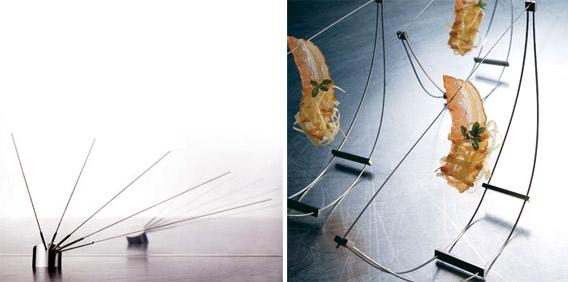
Design by Martin Kastner/Crucial Detail. Photos by Lara Kastner.
Perhaps, then, it is interesting to consider the future of utensils. At his restaurant Alinea, in Chicago, chef Grant Achatz has worked closely with designer Martin Kastner to devise new utensils: the antenna, which supports a single morsel of mackerel; the bow, which allows a transparent slice of bacon to hang freely; and more. Does this seem a bit silly? Yes. Is it genuinely geared to making the food more delicious, and more interesting, to eat? Also yes. And before you imagine yourself incapable, or at least undesiring, of leaning forward, hands-free, to snatch a morsel of food off a thin, wavering stalk of metal with your mouth, just remember that the humble fork used to appear every bit as silly.
Correction, June 21, 2012: The final photo caption on this article misidentified a utensil design as the Squid. The photo depicts a Peacock design.






